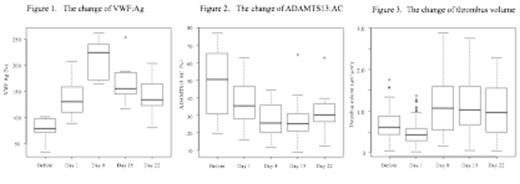Abstract

Background: The patients with severe aortic-valve stenosis (AS) are often complicated with bleeding episodes. The association between AS and gastrointestinal bleeding due to angiodysplasia is reported as Heyde's syndrome, which is categorized as one of the acquired von Willebrand disease (AVWD) in cardiovascular disorders. An international survey has shown that Type 2A is the common subtype of AVWD in the patients with AS. AVWD Type 2A is characterized by impaired platelet-dependent VWF function caused by marked decrease or absence of the most hemostatically active HMW-VWFM. In the patients with AS, a significant correlation between the increased high shear stress and loss of HMW-VWFM in vivo. Further, the absence of HMW-VWFM and bleeding tendency are normalized after valve replacement. These results suggest that enhanced proteolysis of von Willebrand factor (VWF) as it passes through the stenotic valve may induce the loss of HMW-VWFM because high shear stress can induce structure changes in VWF, which is sensitive form to the VWF cleaving protease, termed ADAMTS13. Here, we performed investigation of plasma levels of VWF antigen (VWF:Ag), ADAMTS13 activity (ADAMTS13:AC), and platelet thrombus formation in the patients with AS by valve replacement to confirm the pathophysiological mechanism of this rare disease.
Patients and Methods: Ten consecutive patients who underwent aortic valve replacement for AS in Nara Medical University Hospital were enrolled in this study. The severity of AS was judged by the American Heart Association guideline. All patients had no bleeding history and received bovine tissue valves replacement followed by administration of warfarin and/or anti-platelet agents for prevention of thrombosis a week after surgery. We collected a series of blood samples from these patients before and day1, 8, 15, 22 after valve replacement. Excluding one patient who developed critical cardiac failure just after valve replacement, 9 patients were eventually evaluated by analyses of VWF:Ag, VWF multimers, ADAMTS13:AC, and mural thrombus formation using flow chamber system. VWF:Ag was measured by sandwich ELISA using a rabbit anti-human VWF polyclonal antiserum. Analysis of VWF multimers was performed according to the method of Ruggeri and Zimmerman. ADAMTS13:AC was measured by a chromogenic ADAMTS13-act-ELISA. Platelet thrombus formation was evaluated by thrombus generation under a high shear stress in a parallel plate flow chamber system. Briefly, whole blood anti-coagulated with argatroban was incubated with the fluorescent dye DiOC6 (1uM), and these samples containing DiOC6 -labeled platelets were perfused for 7 min over a type I collagen-coated glass surface under a high shear rate (1500 s-1). The DiOC6 fluorescence corresponding to the platelets was examined at an excitation wavelength of 488 nm with a barrier filter at 500 nm. The percentage of the area covered by adhering platelets (surface coverage) and each thrombus volume were evaluated.
Results: Plasma levels of VWF:Ag before surgery were 78.1 % (median) and those on day 1, 8, 15, 22 after surgery were 130, 224, 155, and 134 %, respectively (Fig 1). Conversely, these levels of ADAMTS13:AC were 50.5, 35.5, 25.5, 25.1, and 30.3 %, respectively (Fig 2). The ratio of VWF:Ag/ADAMTS13:AC at before and day 1, 8, 15, 22 after surgery were 1.6, 4.5, 8.1, 6.1, and 4.1, respectively. In VWF multimer analysis, we found the obvious defect of HMW-VWFM in 7 of 9 patients before surgery, who were diagnosed with severe AS. The remaining two patients had moderate AS with the slight defect of HMW-VWFM. These defects were improved within 14 days after surgery. In platelet thrombus formation, the amount of thrombus volumes significantly increased at day 8, 15, and 22 after compared with before surgery (Fig 3).
Conclusion: The dramatic recovery of platelet thrombus formation was observed in the patients with AS by valve replacement. The rapid increment of VWF and normalization of VWFM pattern, together with reduction of ADAMTS13 after valve replacement suggested heightened proteolysis of VWF by ADAMTS13 under high shear stress would be a major cause of this unique bleeding complication. The highest ratio of VWF:Ag/ADAMTS13:AC at day 8 after surgery might imply the necessity of blockade of heightened VWF function with anti-platelet agents.
Matsumoto:Alfresa Pharma Corporation: Patents & Royalties. Fujimura:Alfresa Pharma Corporation: Patents & Royalties.
Author notes
Asterisk with author names denotes non-ASH members.

This icon denotes a clinically relevant abstract


This feature is available to Subscribers Only
Sign In or Create an Account Close Modal